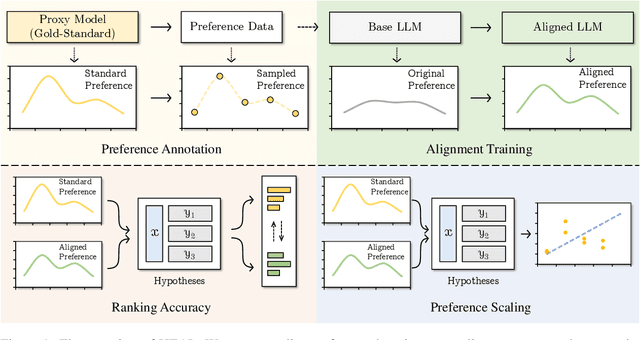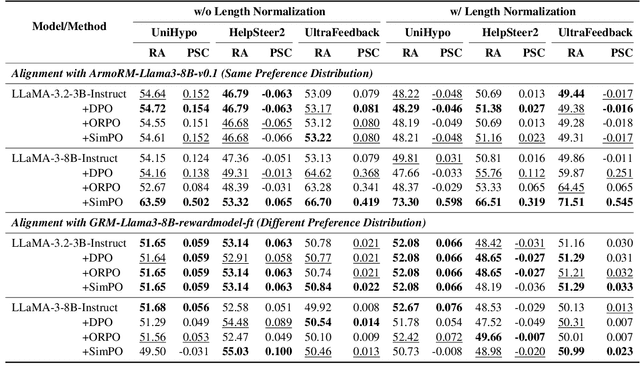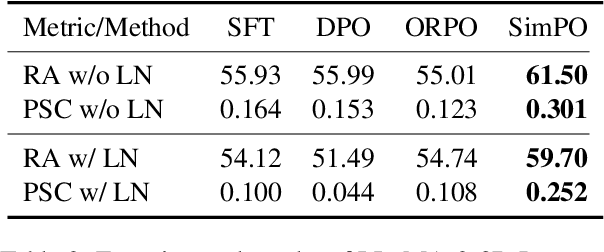Yifu Huo
HEAL: A Hypothesis-Based Preference-Aware Analysis Framework
Aug 27, 2025



Abstract:Preference optimization methods like DPO have achieved remarkable performance in LLM alignment. However, the evaluation for these methods relies on a single response and overlooks other potential outputs, which could also be generated in real-world applications within this hypothetical space. To address this issue, this paper presents a \textbf{H}ypothesis-based Pr\textbf{E}ference-aware \textbf{A}na\textbf{L}ysis Framework (HEAL), a novel evaluation paradigm that formulates preference alignment as a re-ranking process within hypothesis spaces. The framework incorporates two complementary metrics: ranking accuracy for evaluating ordinal consistency and preference strength correlation for assessing continuous alignment. To facilitate this framework, we develop UniHypoBench, a unified hypothesis benchmark constructed from diverse instruction-response pairs. Through extensive experiments based on HEAL, with a particular focus on the intrinsic mechanisms of preference learning, we demonstrate that current preference learning methods can effectively capture preferences provided by proxy models while simultaneously suppressing negative samples. These findings contribute to preference learning research through two significant avenues. Theoretically, we introduce hypothesis space analysis as an innovative paradigm for understanding preference alignment. Practically, HEAL offers researchers robust diagnostic tools for refining preference optimization methods, while our empirical results identify promising directions for developing more advanced alignment algorithms capable of comprehensive preference capture.
LaTeXTrans: Structured LaTeX Translation with Multi-Agent Coordination
Aug 26, 2025Abstract:Despite the remarkable progress of modern machine translation (MT) systems on general-domain texts, translating structured LaTeX-formatted documents remains a significant challenge. These documents typically interleave natural language with domain-specific syntax, such as mathematical equations, tables, figures, and cross-references, all of which must be accurately preserved to maintain semantic integrity and compilability. In this paper, we introduce LaTeXTrans, a collaborative multi-agent system designed to address this challenge. LaTeXTrans ensures format preservation, structural fidelity, and terminology consistency through six specialized agents: 1) a Parser that decomposes LaTeX into translation-friendly units via placeholder substitution and syntax filtering; 2) a Translator, Validator, Summarizer, and Terminology Extractor that work collaboratively to ensure context-aware, self-correcting, and terminology-consistent translations; 3) a Generator that reconstructs the translated content into well-structured LaTeX documents. Experimental results demonstrate that LaTeXTrans can outperform mainstream MT systems in both translation accuracy and structural fidelity, offering an effective and practical solution for translating LaTeX-formatted documents.
GRAM: A Generative Foundation Reward Model for Reward Generalization
Jun 18, 2025Abstract:In aligning large language models (LLMs), reward models have played an important role, but are standardly trained as discriminative models and rely only on labeled human preference data. In this paper, we explore methods that train reward models using both unlabeled and labeled data. Building on the generative models in LLMs, we develop a generative reward model that is first trained via large-scale unsupervised learning and then fine-tuned via supervised learning. We also show that by using label smoothing, we are in fact optimizing a regularized pairwise ranking loss. This result, in turn, provides a new view of training reward models, which links generative models and discriminative models under the same class of training objectives. The outcome of these techniques is a foundation reward model, which can be applied to a wide range of tasks with little or no further fine-tuning effort. Extensive experiments show that this model generalizes well across several tasks, including response ranking, reinforcement learning from human feedback, and task adaptation with fine-tuning, achieving significant performance improvements over several strong baseline models.
LRHP: Learning Representations for Human Preferences via Preference Pairs
Oct 06, 2024



Abstract:To improve human-preference alignment training, current research has developed numerous preference datasets consisting of preference pairs labeled as "preferred" or "dispreferred". These preference pairs are typically used to encode human preferences into a single numerical value through reward modeling, which acts as a reward signal during reinforcement learning from human feedback (RLHF). However, representing these human preferences as a numerical value complicates the analysis of these preferences and restricts their broader applications other than RLHF. In contrast, in this work, we introduce a preference representation learning task that aims to construct a richer and more structured representation of human preferences. We further develop a more generalizable framework, Learning Representations for Human Preferences via preference pairs (namely LRHP), which extends beyond traditional reward modeling to tackle this task. We verify the utility of preference representations in two downstream tasks: preference data selection and preference margin prediction. Building upon the human preferences in representations, we achieve strong performance in both tasks, significantly outperforming baselines.
RoVRM: A Robust Visual Reward Model Optimized via Auxiliary Textual Preference Data
Aug 22, 2024



Abstract:Large vision-language models (LVLMs) often fail to align with human preferences, leading to issues like generating misleading content without proper visual context (also known as hallucination). A promising solution to this problem is using human-preference alignment techniques, such as best-of-n sampling and reinforcement learning. However, these techniques face the difficulty arising from the scarcity of visual preference data, which is required to train a visual reward model (VRM). In this work, we continue the line of research. We present a Robust Visual Reward Model (RoVRM) which improves human-preference alignment for LVLMs. RoVRM leverages auxiliary textual preference data through a three-phase progressive training and optimal transport-based preference data selection to effectively mitigate the scarcity of visual preference data. We experiment with RoVRM on the commonly used vision-language tasks based on the LLaVA-1.5-7B and -13B models. Experimental results demonstrate that RoVRM consistently outperforms traditional VRMs. Furthermore, our three-phase progressive training and preference data selection approaches can yield consistent performance gains over ranking-based alignment techniques, such as direct preference optimization.
ESRL: Efficient Sampling-based Reinforcement Learning for Sequence Generation
Aug 04, 2023



Abstract:Applying Reinforcement Learning (RL) to sequence generation models enables the direct optimization of long-term rewards (\textit{e.g.,} BLEU and human feedback), but typically requires large-scale sampling over a space of action sequences. This is a computational challenge as presented by the practice of sequence generation problems, such as machine translation, where we often deal with a large action space (\textit{e.g.,} a vocabulary) and a long action sequence (\textit{e.g.,} a translation). In this work, we introduce two-stage sampling and dynamic sampling approaches to improve the sampling efficiency during training sequence generation models via RL. We experiment with our approaches on the traditional sequence generation tasks, including machine translation and abstractive summarization. Furthermore, we evaluate our approaches in RL from human feedback (RLHF) through training a large language model using the reward model. Experimental results show that the efficient sampling-based RL, referred to as ESRL, can outperform all baselines in terms of both training efficiency and memory consumption. Notably, ESRL yields consistent performance gains over the strong REINFORCE, minimum risk training, and proximal policy optimization methods.
 Add to Chrome
Add to Chrome Add to Firefox
Add to Firefox Add to Edge
Add to Edge